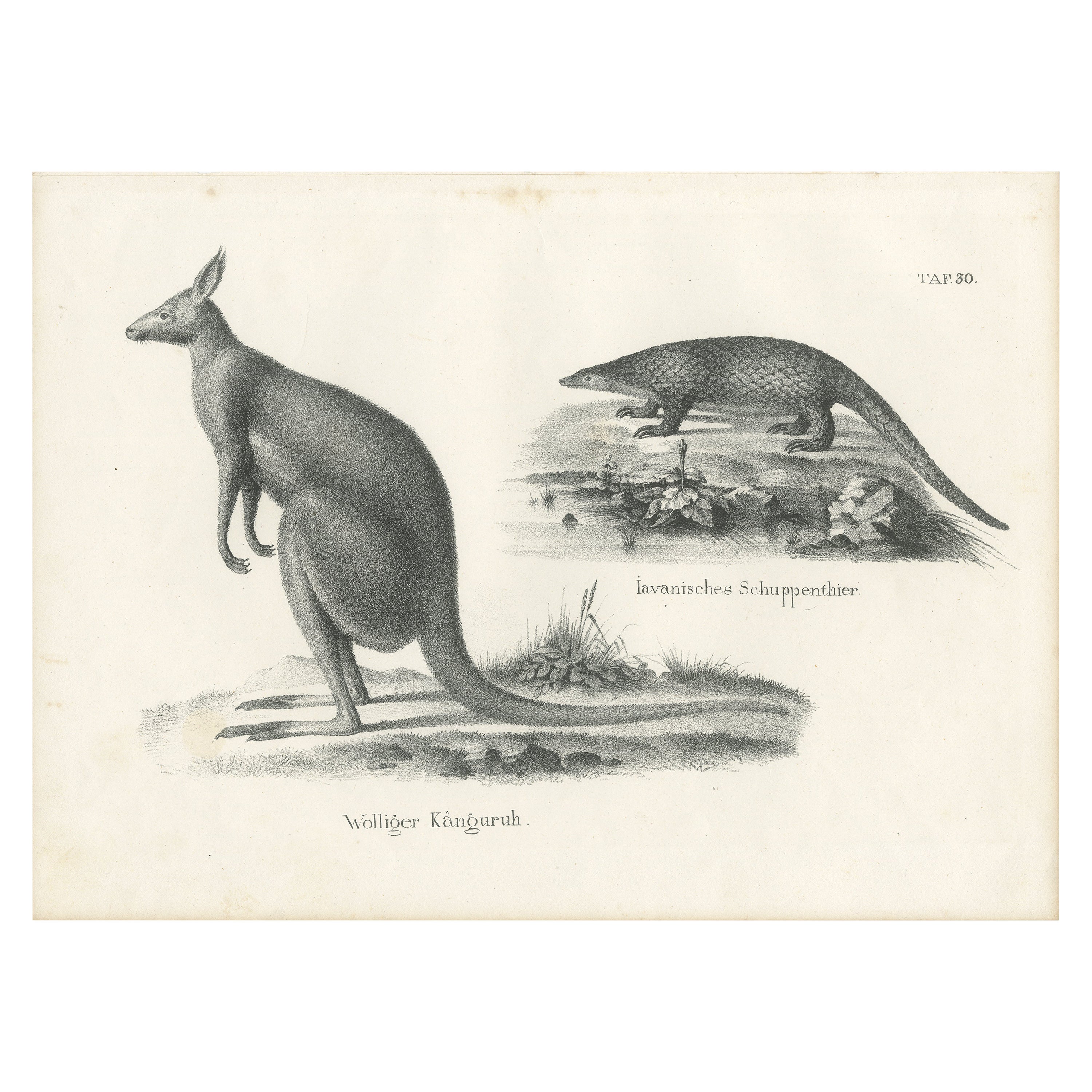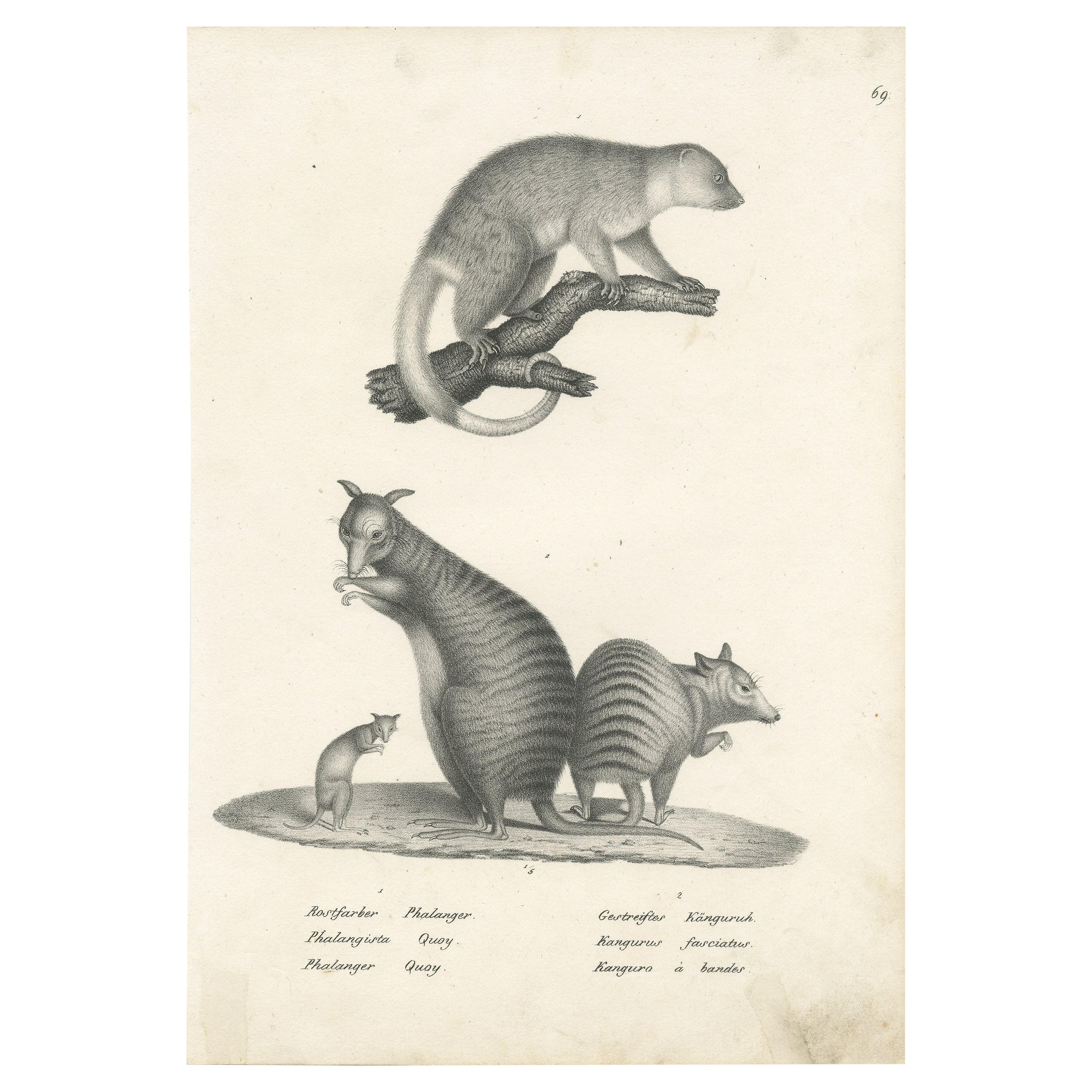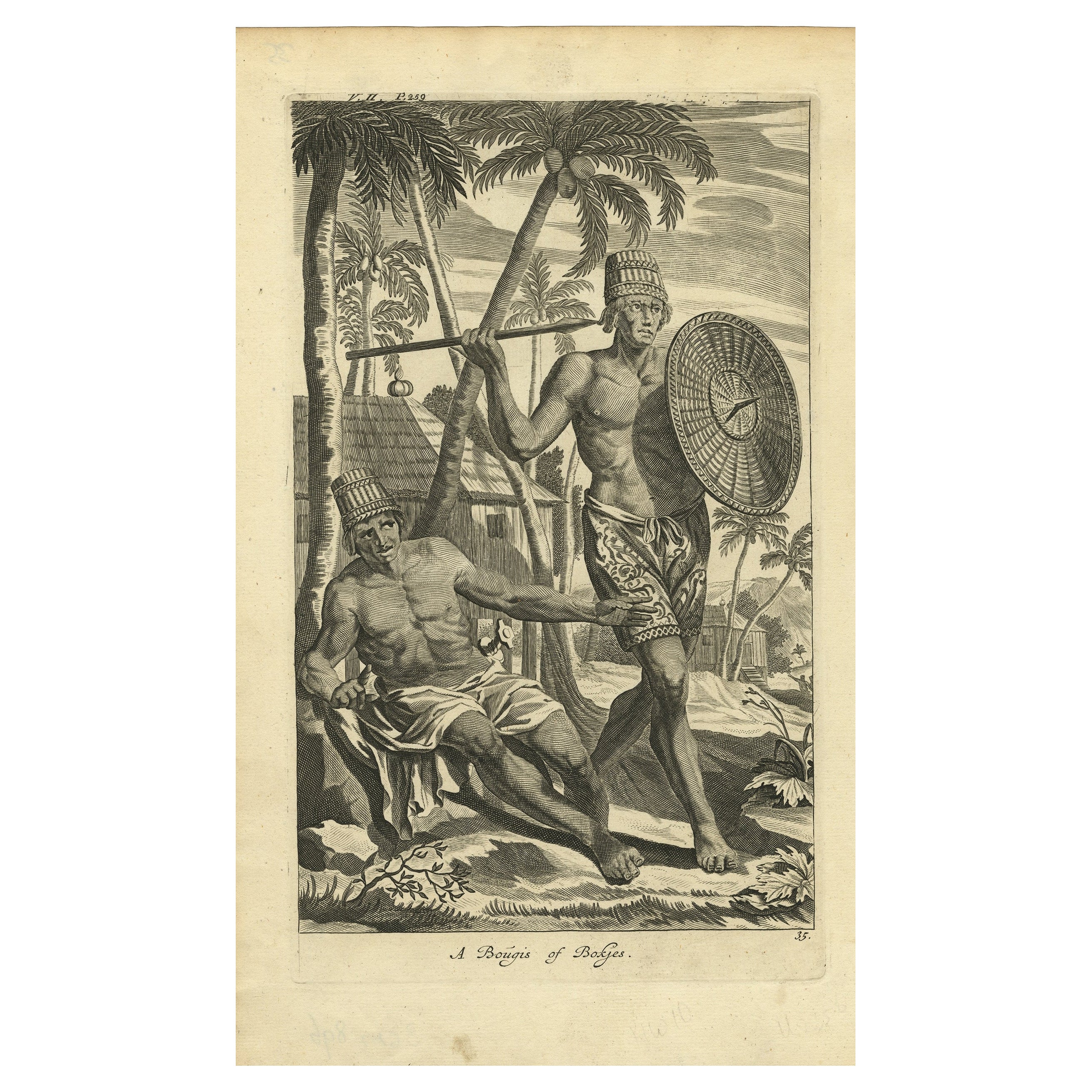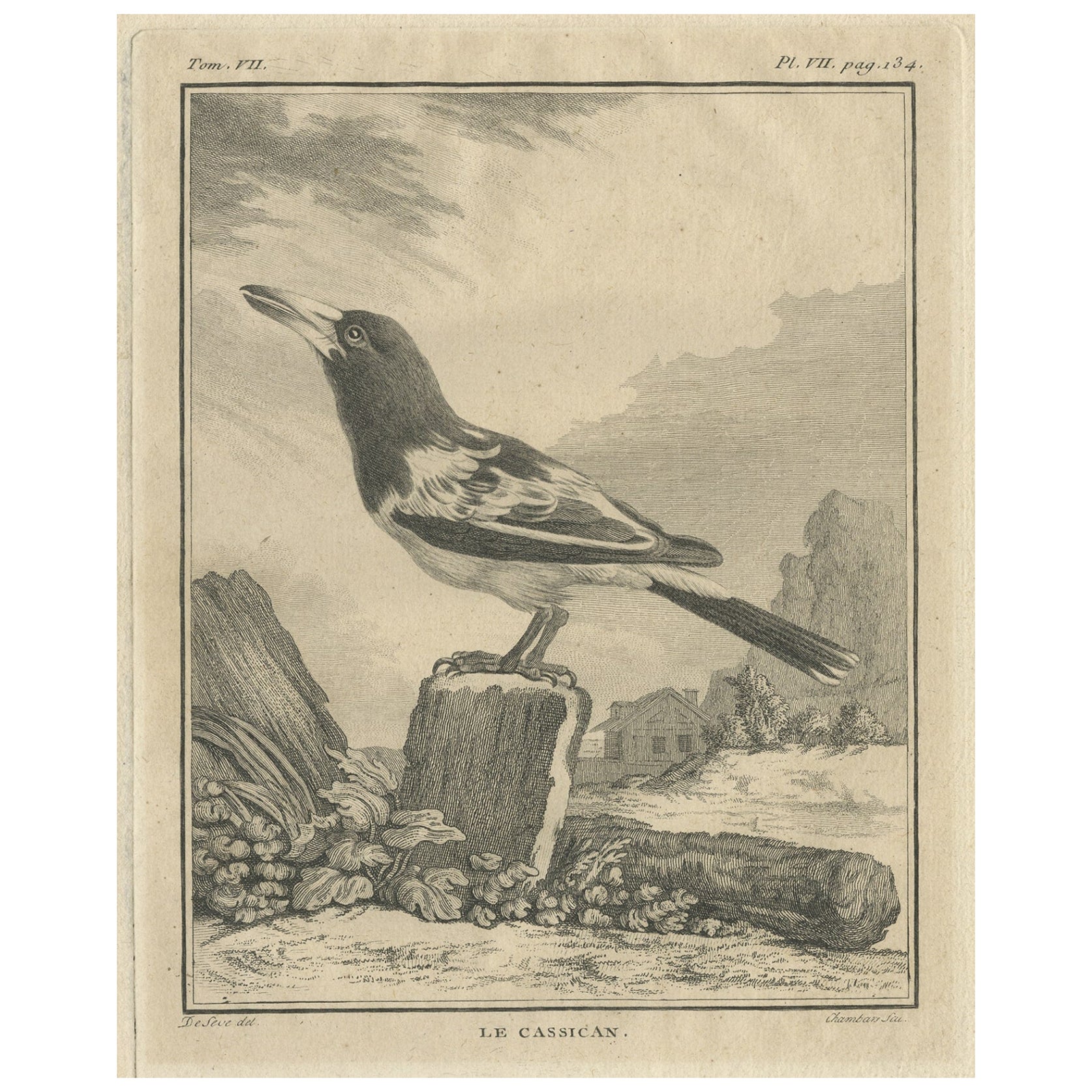Items Similar to Antique Copper Engraving of a Kangaroo in Australia, 1744
Want more images or videos?
Request additional images or videos from the seller
1 of 6
Antique Copper Engraving of a Kangaroo in Australia, 1744
About the Item
The title 'Quadrupede Nomme Kanguroo, Trouve sur la Cote de la N'le Hollande' refers to an uncolored engraving depicting a Kangaroo, originally found and described during Captain Cook's first voyage, later rendered by George Stubbs in the English account. This French version offers a portrayal of the Kangaroo encountered on the coast of New Holland (Australia) during that expedition.
The Kangaroo illustration, an integral part of the narrative from Cook's exploration, became renowned due to its significance in the documentation of newly discovered fauna. George Stubbs, a celebrated artist, interpreted and immortalized this image in the English account of Cook's voyage.
This uncolored engraving presents a historical representation of the Kangaroo, an iconic symbol of Australia's unique wildlife, as observed and documented during a pivotal period of exploration. The illustration stands as a testament to the scientific curiosity and documentation prevalent during early voyages of discovery, contributing to the understanding and documentation of the natural world in the 18th century.
The print is in good condition, considering its age, but does have a few slightly visible vertical creases and some soiling. Nevertheless a very representable print of a few hunderd years old (1744).
Description:
This engraving is based on the first illustration of a “Kangaroo” an Australian species, drawn by George Stubbs from a specimen collected at Endeavour River in 1770 by James Cook’s crew while the Endeavour was being careened and issued in the official accounts of the voyage of the Endeavour. This iconic image captured the public’s imagination for over sixty years and was the first depiction of any Australian animal in western art. Confusion exists as to the original species described, based on the specimens brought back by Cook and the subsequent painting by Stubbs. This situation arose in the comparisons of drawings and photographs which are the only records of the lost original specimens, with Parkinson’s sketch made on 23rd June 1770 at Endeavour River and the later Stubbs painting. Parkinson’s sketches and paintings of natural history subjects held in public institutions, clearly show a prodigious artistic talent, and his sketch of a kangaroo made on the spot, is certainly a more realistic depiction than the later version painted by Stubbs that has exaggerated features. Stubbs had the disadvantages of not seeing a live animal and only having the dried skin that was brought back by Cook to work from. It is probable that the skin was firstly re-hydrated and then inflated for Stubbs to be able paint the animal. It has been established that the kangaroos collected on Cook’s expedition near Cooktown were specimens of the Grey Kangaroo, Macropus giganteus (Roland Strachan CBOM p.244).
The first sighting of a kangaroo in fact was an earlier one, by Francis Pelsaert of “the teeming cats” on 15th November, 1629 on the Abrolhos Islands where the Batavia had been wrecked.
The first illustration of a Macropod was made prior to the Stubbs illustration, titled ‘Kangaron’ and made on 15th November 1629 by Matthys Pool and described by Cornelis de Bruyn in Reizen over Moskovie door Persie en Indie, 1714 but the animal depicted was not an Australian species but Thylogale brunii (Dusky Pademelon), a Filander native to New Guinea.
From Cook’s published accounts Endeavour River Qld First sighting of a Kangaroo 22 June 1770 Joseph Banks;
‘The People who were sent to the other side of the water in order to shoot Pigeons saw an animal as large as a grey hound, of a mouse colour and very swift..’
Cook sees a kangaroo 24 June 1770 James Cook;
‘I saw my self this morning a little way from the ship one of the Animals before spoke off, it was of a light Mouse colour and the full size of a grey hound and shaped in every respect like one’.
The animal named 4 August 1770 James Cook;
‘the Animal which I have before mentioned is called by the natives Kangooroo or Kanguru.
In a study made by W.E.Ling-Roth of the north-west central Queensland Aborigines in 1897, he found that there might have been confusion with the word ‘ganguru’ which meant simply ‘don’t understand your question’. The spelling ‘kanguroo’ prevailed for nearly half a century until the modern version became the standard.
References Lennox-boyd George Stubbs 1989 pg 138 plate 35.III, Hawkesworth An account of the Voyages, 1773 Plate 20, Younger Kangaroo Images Through.. 1988 Pg 47 ill. Pg 46.
George Stubbs (1724 - 1806)
Stubbs was classified in his lifetime as a sporting painter, and as such was excluded from full membership of the Royal Academy. He is best remembered for his paintings of horses and his conversation pieces. Having studied anatomy, Stubbs's pictures of horses are among the most accurate ever painted. Stubbs was born in Liverpool, the son of a leather worker, and he spent his early career painting portraits and developing his interest in anatomy. In the 1740s he lived in York and supplied the illustrations for a treatise on midwifery. Following a brief visit to Rome in 1754, he settled in Lincolnshire, where he researched his major publication, The Anatomy of the Horse. In about 1758 he moved to London, which remained his base. Early clients for his sporting and racing paintings included many of the noblemen who founded the Jockey Club. Like Gainsborough, he later painted scenes of peasant life, as well as studies of wild and exotic animals. He also became known as a printmaker and for his paintings in enamel on Wedgwood earthenware plaques.
- Dimensions:Height: 9.85 in (25 cm)Width: 7.49 in (19 cm)Depth: 0 in (0.02 mm)
- Materials and Techniques:
- Period:1740-1749
- Date of Manufacture:1744
- Condition:Wear consistent with age and use. Good. Soiling due to age and handling. Brown spot on the middle right. Study the image carefully.
- Seller Location:Langweer, NL
- Reference Number:
About the Seller
5.0
Platinum Seller
These expertly vetted sellers are 1stDibs' most experienced sellers and are rated highest by our customers.
Established in 2009
1stDibs seller since 2017
1,940 sales on 1stDibs
Typical response time: <1 hour
- ShippingRetrieving quote...Ships From: Langweer, Netherlands
- Return PolicyA return for this item may be initiated within 14 days of delivery.
More From This SellerView All
- Antique Engravings of an Australian Kangaroo and a Vari of Madagascar, c.1780Located in Langweer, NLEngraving by Rennoldson (18th Century British School) with nice decorative border. 1) A Remarkable Animal Found on One of the Hope Islands in Capt Cook's First Voyage. 2) The Va...Category
Antique 1770s Prints
MaterialsPaper
- Antique Print of Kangaroo and a 'Javanese' Pangolin in Australia, c.1825Located in Langweer, NLA antique print depicting a 'Wolliger Kanguruh' (a kangaroo) and a 'Iavanisches Schuppenthier' (a Pangolin, a scaly anteater) from a German publication around 1825-1830. Heinri...Category
Antique 1820s Prints
MaterialsPaper
- Antique Print Showing the Phalanger and the Striped Kangaroo in Australia, 1825Located in Langweer, NLThis original antique print originates from 'Naturgeschichte Abbildungen der Saugethiere' by H. R. Schinz, published by J. F. Schleijer c.1825. This work on mammals was part of a ser...Category
Antique 1820s Prints
MaterialsPaper
- Engraving of Buginese people near Batavia, East Indies, Indonesia, 1744By Philip BaldaeusLocated in Langweer, NLAntique print, titled: 'A Bougis of Bokjes' - This plate shows Buginese people near Batavia, East Indies, Indonesia. The Buginese people are an ethnic group - the most numerous o...Category
Antique 18th Century Prints
MaterialsPaper
- Antique Engraving of the Cassican Bird, a Corn Bird or Australian Magpie, 1795By Georges-Louis Leclerc, Comte de BuffonLocated in Langweer, NLAntique print titled ‘Le Cassican’. This print depicts the cassican bird and originates from Buffon’s ‘Histoire Naturelle’, published in Paris 1795. Artists and Engravers: Comte d...Category
Antique 18th Century Prints
MaterialsPaper
- Antique Copper Plate Engraving Depicting Natives of Tahiti Dancing, 1803Located in Langweer, NLAntique print titled 'Dans van O-Tahiti'. Antique print depicting natives of Tahiti, dancing. Originates from 'Reizen Rondom de Waereld door James Cook (..)'. Artists and Eng...Category
Antique Early 1800s Prints
MaterialsPaper
You May Also Like
- Antique Copper Engraving of an Officer of Pikeman by Francis GroseBy Francis GroseLocated in New York, NYFrancis Grose entered the army early in life and served in the cavalry, infantry, and militia.He had a profound knowledge of antiquities and spent the greater part of his life collec...Category
Antique 19th Century English Renaissance Revival Prints
MaterialsPaper
- Antique French Madam Knipp Engraving of PigeonLocated in Downingtown, PAMadam Knipp engraving of pigeon, From Les pigeons par Madame Knip, ne´e Pauline de Courcelles ; le texte par C.J. Themminck, Paris France, 1809-1811. A remarkable large engraving of a pigeon- The Colombe Ramier or Columba Cenea or Wood Pigeon floating within a gilt frame and white matte and with UV Tru-view Clear UV Glass. From a large collection of framed...Category
Antique Early 19th Century French Georgian Decorative Art
MaterialsPaper
- Original Antique Print of Geelong, Australia, circa 1850Located in St Annes, LancashireGreat print of Geelong Fine steel engraving after H.Winkles Published, circa 1850 Unframed. Crease to top left cornerCategory
Antique 1850s English Other Prints
MaterialsPaper
- Antique Engraving of a Tucano Mangiapepe by Saverio ManettiLocated in Downingtown, PAAntique engraving of a Tucano Mangiapepe, by Saverio Manetti Circa 1776 A fine hand colored engraving of a Tuscan Magpie by the Italian artist Saverio Manetti. Manetti drew his work predominantly from real specimens. The work was one of the largest ornithology undertakings to that point in time. Dimensions: 25 inches high x 22 inches wide x 1 1/4 inches deep. (frame); (63.5cm high x 55.88cm). 18 x 14 in. (sheet) Reference: Wikipedia Manetti was born in Brozzi to Giovanni Bernardo and Maria Teresa Nesiscolt of Prague. His early studies were in Florence and later at Pisa where he studied botany under Pier Antonio Micheli. He graduated in medicine in 1745 and worked in Florence. In 1758 he joined the National Medical College where he studied anatomy under Antonio Cocchi (1695–1758), conducting the autopsy of Cocchi. Manetti was Professor of Botany of the "Società Botanica Fiorentina", a member of the German Academy of Sciences Leopoldina, a Fellow of the Royal Society, learned societies in Göttingen and Montpellier, an Accademico dell'Istituto di Bologna and he maintained scientific contacts with the Swedish botanist Carl Linnaeus and with the main scientific circles of the second half of the 18th century. He was supervisor of the Orto Botanico di Firenze in Florence from 1749 to 1782 succeeding to Giovanni Targioni Tozzetti and Secretary of the Accademia dei Georgofili. With remarkable organizational effort, he secured the publication of Storia naturale degli uccelli, Natural History of the birds, a monumental work in five volumes illustrated with 600 hand-coloured engravings based on watercolor paintings. The book was commissioned by Maria Luisa, Grand duchess of Tuscany and the first volume was dedicated to Grand Duke Pietro Leopoldo. The third volume was dedicated to Ferdinando di Brobone and the fourth to Giorgio Nassau Clavering. The engravings were made by Tuscan abbot and engraver Lorenzo Lorenzi and Violante Vanni who had studied under British engraver Robert Strange...Category
Antique 1770s Italian Georgian Decorative Art
MaterialsPaper
- Pair of Late Regency Hunt Engravings in Period FramesLocated in Hudson, NYThese two works commemorate the great English pastime of gentlemen hunt parties and social gatherings surrounding the land and its produce to those who own it. This very nice pair of...Category
Antique 1830s English Regency Decorative Art
MaterialsPaper
- Antique 1755 Copperplate Engraving Westminster Bridge Lambeth Survey of LondonLocated in Dayton, OHAntique hand colored riverscape / landscape copperplate engraving based on a painting by Jacob Maurer and engraved by Paul Fourdrinier - A View of Westminster Bridge from Lambeth, published according to Act of Parliament 1754 for Stowe’s Survey of London. BIO: Paul Fourdrinier sometimes referred to as Peter or Pierre Fourdrinier, was an 18th Century engraver in England. Paul Fourdrinier, engraver and printseller, was born on 20 December 1698 in Groningen in the Netherlands, the son of Jacques Fourdrinier and his wife, Jeanne Theroude, Huguenot refugees from Dieppe, Normandy. He was a pupil of Bernard Picart at Amsterdam for six years, and came to England in 1720. He was employed in engraving portraits and book illustrations. He also engraved two works by Peter Monamy, marine paintings displayed in Vauxhall Gardens. The engravings were published in 1743, but may have been executed earlier. Starting in 1742 Fourdrinier produced a series of books consisting of numerous folding charts showing "The Succession of Colonels to all his Majesties Land Forces from their Rise to 1742", as well as many other details of British military and naval personnel. The 2004 edition of the Oxford Dictionary of National Biography makes it clear that in the 19th century edition of the Dictionary of National Biography this engraver's works and career were assigned to two individuals, Peter (or Pierre) and Paul Fourdrinier. Peter/Pierre is now seen to be a fictitious individual resulting from an accidental misnaming of Paul. Paul Fourdrinier is mentioned as the engraver of some of the works listed above, and he has been identified with the Paul Fourdrinier who was of the parish of St. Martin's-in-the-Fields, married to Susanna Grolleau, and who died in January or February 1758. The couple had at least five children, including a son Henry Fourdrinier, whose daughter, or granddaughter, Jemima Fourdrinier was the mother of Cardinal John Henry Newman...Category
Antique Mid-18th Century British Colonial Prints
MaterialsPaper
Recently Viewed
View AllMore Ways To Browse
Over Door Decorations
Engraving Leather
Antique Shooting
Antique Shoot
Antique Ship Door
Antique Furniture West London
Antique Pool
Antique Copper Door
Liverpool Antiques
Animal Print Leather
English 15th
Antique Prints Australia
Antique Enameled Copper
15th Century English
15th Century English
Pictures Of Horses
English 15th Century
Old English Doors





